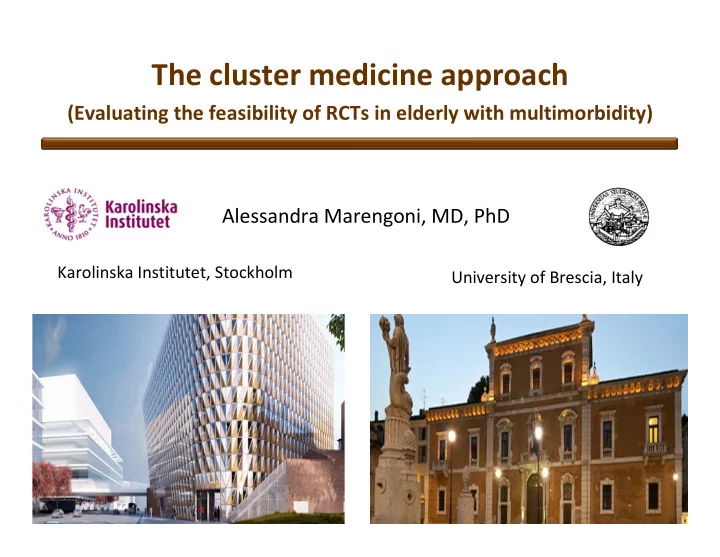

The cluster medicine approach (Evaluating the feasibility of RCTs in elderly with multimorbidity) Alessandra Marengoni, MD, PhD Karolinska Institutet, Stockholm University of Brescia, Italy
HISTORY OF GERIATRIC MEDICINE 1900 THE REAL WORLD Signs and symptoms MULTIMORBIDITY Acute disease Demographic and HETEROGENEIT epidemiological Y Chronic disease transitions COMPLEXITY 2000 - on
‘Complex information can be best recognized as patterns’ Vogt W and Nagel D, Clin Chem 1992 <DATA REDUCTION> (helpful despite a reduction also of information) PATTERNS OR CLUSTERS OF DISEASES: THE CO-OCCURRENCE OF 2 OR MORE SPECIFIC CHRONIC DISEASES THE STUDY OF THE DISTRIBUTION OF CO-OCCURRING DISEASES IN THE POPULATION AND THE IDENTIFICATION AND
Statistical methods Proportion of pairs or triades of diseases : many calculations/large samples Ratio of Observed / Expected Prevalence (multimorbidity coefficient): degree to which comorbid diseases exceed the chance level Odds Ratio, Risk Ratio : statistical issues (i.e. multiple comparisons) overestimation of the effect size
Study design of the Kungsholmen Project 2368 ≥ 75 years 2368 ≥ 75 years Living in the KUNGSHOLMEN area (born ≤ 1912) Living in the KUNGSHOLMEN area (born ≤ 1912) Time 1 423 deaths 1700 1987-1989 PARTICIPANTS 288 refusals or moving 363 deaths Time 2 1099 56 refusals 1991-93 EXAMINED or moving 680 Time 3 EXAMINED 1994-96
RATIO OF OBSERVED/EXPECTED PREVALENCE OF PAIRS OF DISEASES Prevalence per 100 Observed Expected Ratio O/E Heart failure & CHD 5.6 2.6 2.2 Heart failure & Atrial fibrillation 3.8 1.8 2.1 Heart failure & diabetes 1.8 0.9 2.0 Hypertension & Heart failure 15.1 6.7 2.3 Dementia & depression 3.0 1.7 1.8 Dementia & hip fracture 1.7 0.8 2.1 Dementia & CVD 2.7 1.6 1.7 Depression & CVD 1.1 0.6 1.8 Depression & hip fracture 0.6 0.3 2.0 Marengoni et al. JAGS 2009;57:225-30
PREVALENCE OF DISABILITY ACCORDING TO DIFFERENT CLUSTERS OF DISEASES IN THE KP % MARENGONI A AND ANGLEMAN S, 2011;1:11- 18
CLUSTER ANALYSIS : CLUSTERING IS THE GROUPING OF SIMILAR OBJECTS BY USING ALGORITHMS. IT IS BEST SEEN AS HYPOTHESIS- GENERATING RATHER THAN -SOLVING. Similarity -1 measure -.5 0 .5 1 atrial fibrillation diabetes Heart failure visual impairments anaemia CHD CVD deafness malignancy hip fracture thyroid dysfunction COPD hypertension dementia depression CHD=coronary heart diseases CVD=cerebrovascular diseases COPD=chronic obstructive pulmonary diseases Marengoni A and Fratiglioni L, J Am Geriatr Soc 2009;57:225-30
THE RE.PO.SI. STUDY • Designed by the Italian Society of Internal Medicine and the Mario Negri Pharmacological Institute (Milan) • Cross-sectional (2008 e 2010) and Longitudinal Study (2010) • 38 Internal Medicine and Geriatric Wards in Italy in 2008 and 70 in 2010 • 4 weeks, one/season • 1155 patients, 65+ yrs, in 2008 and 1400 in 2010
Diseases OR 95% CI Hypertension 2.3 1.8-2.9 Diabetes mellitus 1.9 1.4-2.8 Coronary heart disease 4.0 2.7-6.1 Atrial fibrillation 2.7 1.9-3.7 Chronic pulmonary disease 1.9 1.3-2.9 Cerebrovascular disease 1.5 1.1-2.0 Malignancy 0.6 0.4-0.9 Dyslipidemia 2.4 1.6-3.7 Chronic renal failure 2.1 1.3-3.3 Thyroid diseases 2.4 1.4-4.1 Heart failure 3.6 1.6-8.1
OR Adjusted for age, gender, Charlson Index, participating centers
CLUSTERS OF DISEASES AND ANTICHOLINERGIC BURDEN Anticholinergic Cognitive Burden scale (ACB) Number of patients Mean score treated with Clusters ACB (sum score) anticholinergic drugs (%) 1 2 (78) 32 (82.0) 2 1.4 (21) 9 (56.3) 3 1.1 (35) 7 (22.6) 4 1.7 (125) 64 (87.7) Unpublished data
NETWORK MEDICINE: ‘a network-based appoach to human disease’ ‘Uncovering links between disease help us understand how different phenotypes are linked at the molecular level, but also help us to comprehend why certain groups of diseases arise together’ ‘…one can also link disease pairs on the basis of the directly observed coexistence between them, thereby obtaining a phenotypic disease network...’ Barabasi Al and Loscalzo J, Nat Rev 2011;12. Goh K et al. PNAS 2007;104:8685-8690
RESEARCH HYPOTHESES MAY DIFFERENT OUTCOMES/PROGNOSIS IN MULTIMORBID ELDERLY BE BETTER EXPLAINED BY DISEASE CLUSTERS? MAY STUDIES ON SELECTED DISEASE CLUSTERS EXPLAIN: • HIGHER RISK OF ADVERSE DRUG EVENTS? • DIFFERENT RESPONSIVENESS? • DIFFERENT COSTS? IDEALLY, CAN WE DESIGN A CLINICAL TRIAL AIMING TO CHANGE THE CHAIN OF EVENTS (REDUCE OR SLOW DOWN DISEASE CLUSTERING)? OUTCOMES NOT BASED ON DISEASE SPECIFIC INDICATORS BUT GOAL ORIENTED PATIENTS CARE: INDEPENDENCY , QUALITY OF LIFE, ..
Recommend
More recommend